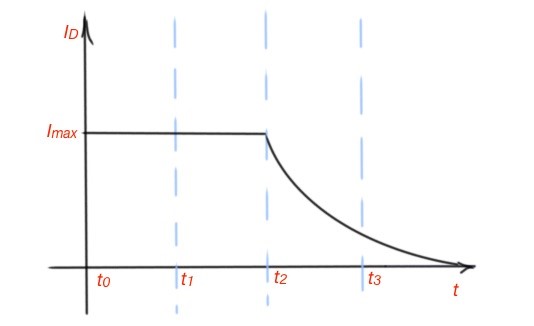It is very important to understand switching characteristics of power MOSFET. To understand the turn-on and turn–off process in power MOSFETs, we have to consider the simplified equivalent circuits of the power MOSFET in turn-on and turn-off states. When the power MOSFET is off, , and . Let’s first consider turn-on processes among power MOSFET switching characteristics.
- , when the voltage is applied, the gate source voltage starts to control the drain-source current, and the capacitor charges through the resistor .
- , when the , the transistor is in the cut-off mode and This time is needed to charge capacitor , and this means delay in time before transistor will turn on. Capacitor charges to the voltage level . The gate current, here is gate-to-ground voltage, and is a drain-to-ground voltage. And gate current Resolving these exponential equations we can show that , where , and gate current , . Resistance is characterising conducting state of power MOSFET.
- , then MOSFET start to conduct current. Delay time .
- and , so the becomes a function of and .
- and , raises exponentially and is characterised by function , here is a coefficient, and , .
- the drain turns off. Resolving exponential equation we can obtain .
- , the drain is closed, . From the equations above .
- , MOSFET turns off ,, capacitance is discharging, , current flows through .
- flows through capacitance , , gate voltage raises until moment of time , when gate current and MOSFET is completely turned off. Time interval .
- Total delay when power MOSFET is on-state is , there is a high current and voltage goes through the device during periods of time and , that provokes high power losses in MOSFET. Smaller resistance will decrease power losses.


Now we know turn-on part of power MOSFET switching characteristics, so we can consider the turn-off part in the power MOSFET as well. We can assume that the device is on for .
- When The equivalent circuit is depicted on figures 2-4. When , and are discharging, gate-to-source voltage is . Current through the capacitor reaches the constant value . So .
- When , so the current goes through the , .
- When , the drain current becomes 0, and the service is turned off, .
- When the gate voltage continues to fall to 0, and the voltage function is exponential. The gate-to-drain capacitance charges to the value.
- When drain current decreases to 0.



The extreme modess of power MOSFETs were explained above. As you can see it is very important to understand every switching characteristics of power MOSFET as MOSFETs are used a lot like switch devices. Let’s briefly consider the Safe Operating Area (SOA). The SOA provides the limits of the power MOSFET to work. Figure 3 depicts the SOA for one of the power MOSFETs from the Infineon product line.
Maximum current is determined by the maximum power dissipation of the MOSFET and follows the formula and corresponds to the on-state of the power MOSFET. The drain-to-source voltage is growing. The MOSFET starts to work in the saturation mode. Here the device experiences big values of current and voltage. When the drain-to-source voltage grows further the device experiences the avalanche breakdown (it is indicated as the second breakdown limit). Digi-Key Electronics has a great selection power MOSFETs.

(«Power Electronics Handbook», 3rd edition, M.H. Rashid.; «Infineon OptiMOS Power MOSFET datasheet explanation», Infineon Technology AG.)




